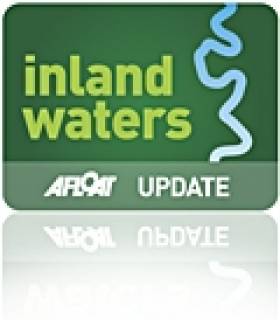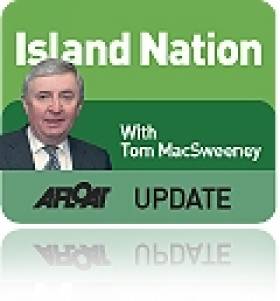Displaying items by tag: InterCounties
#inland – Sailing will be centre stage when teams from around Ireland battle it out in the Grand Canal Dock, Dublin over two days for the second edition of the Inter-Counties Sailing Championship to see which county has the best sailing team.
Notice of Race is downloadable below as a PDF.
Sailors are invited to submit a team comprising a crew of up to 5 people capable of handling a 27ft keel boat, to include at least 1 female, to represent counties in what will be the battle of the sailing tribes & colours of Ireland. Which county is the best?
Racing will comprise a series of sprint flights (heats) of approximately 20 minutes duration leading to a final to decide the winner.
With boats constantly in close quarters and potential crash situations both with each other and the immovable solid quay walls, this event promises to be a testing and thrilling experience for the sailors crewing onboard and a highly entertaining spectacle with viewing areas for spectators on the quay walls and the Grand Canal Square.
The championship will run over the weekend of 7th & 8th September 2013 from 1000hrs - 1600hrs each day.
A fleet of one design boats 27ft in length is being provided so teams can compete on a level playing field. Ownership of a boat is not necessary, and sailors and clubs wishing to enter a team to represent their county should contact Waterways Racing for more details.
The Grand Canal Dock is part of Ireland's inland waterways system and comprises 44 acres of non-tidal freshwater in Dublin's Docklands. It has its own marina, Waterways Interpretive Centre, watersports centre and is surround by a multitude of bars and restaurants and is overlooked by the majestic Bord Gáis Energy Theatre.
The event is being supported by Waterways Ireland, an all island body set up to manage & promote all of Ireland's waterways. Commenting on their support of the event "We are delighted to be involved in this sailing championship which invites participation from the whole island of Ireland in keeping with our own remit as an inter-governmental agency. We are looking forward to welcoming teams, supporters and the general public to this historic dock in Dublin for the inaugural Waterways Ireland Inter-Counties Sailing Championship" Éanna Rowe, Marketing Manager, Waterways Ireland.
The Waterways Ireland Inter-Counties Sailing Championship 2011 is seeking more entries for the fresh water event taking place on June 26th in Dublin. So far six counties are entered but organiser Paul O'Riain is hoping to double that number for the inaugural event in three weeks time.
The championship will take place on the Grand Canal Dock a huge 44 acre dock in the heart of Dublin’s sparkling new Docklands.
Boats are being provided and event entry fee is only €200 for a team of 5 people, that’s only €40 per head with everything included so teams can just turn up and race. Boats will be available the day before for practice and familiarisation.
The organisers still have places for the following counties, which have yet to formally enter a team;
Antrim, Armagh, Carlow, Cavan, Cork, Down, Dublin, Derry, Fermanagh, Kerry, Kildare, Kilkenny, Laois, Leitrim Longford, Louth, Mayo, Meath, Monaghan, Offaly, Roscommon, Sligo, Tipperary, Tyrone, Waterford, Westmeath Wexford and Wicklow.
This is an open invitaton to sailors, clubs and teams keen to do battle & represent their country, to contact the organisers about entering their team and county without delay as entry is limited to 20 county teams only for this inaugural event
The Deadline for entry is in ten days time, Friday 10th of June 2011.
For more information please contact the event director Paul Ó Riain at; +353 (0) 87 23 55 900
The First All Ireland Counties Sailing Championships
He has come up with the idea of a Waterways Ireland Inter-Counties Sailing Championship, which will be held on Sunday, June 26, at the Grand Canal Dock in Dublin.
Waterways has responsibility for the management, maintenance, development and restoration of inland navigable waterways, principally for recreational purposes. It is one of the six North/South Implementation Bodies established under the British-Irish Agreement of 1999.The waterways under the remit of the body are the Barrow Navigation, the Erne System, the Grand Canal, the Lower Bann, the Royal, the Shannon-Erne Waterway and the Shannon Navigation.
"What we intend is to make sailing centre stage in midsummer," he told me. "We are inviting teams from counties throughout Ireland to battle in the heart of Dublin for the first time to see which county has the best sailing team."
The invitation is not limited to clubs only.
"Sailors from around Ireland are invited to form teams composed of a crew of up to 5 people capable of handling a 27ft keel boat, including at least 1 female, to represent their counties in what will be the battle of the sailing tribes and colours of Ireland. We will find out which county is the best. This is the chance to find out. Racing will be in a series of sprint heats of approximately 20 minutes each leading to semi-finals and finals to decide the winner."
With boats constantly in close quarters, both with each other and the quayside walls, this should be a testing and somewhat 'thrilling' experience for the sailors! It should also be an entertaining spectacle for the public with viewing areas on the quay walls and at Grand Canal Square.
The championship will be sailed from 9 a.m. to 4 p.m. A fleet of the 1720 one-design boats, 27 feet in length, will be provided so that teams compete on a level basis, making skill the deciding factor.
The website is www.waterwaysracing.com
This builds on the Liffey Docklands Challenge which initiated sailboat racing on the Liffey near the city centre. The Grand Canal Dock is part of Ireland's inland waterways system and comprises forty-four acres of non-tidal freshwater in Dublin's Docklands. It has its own marina and a watersports centre, with adjacent hostelries and restaurants, as well as the Grand Canal Theatre.
"This event will be a centrepiece in the Docklands Summer Festival," says Paul, who competed in the French single-handed Figaro Race and is one of those developing the Irish Double and Solo Racing Group. The event will be sponsored by Waterways Ireland.
"We are delighted to do so and hope for participation from both North and South, in keeping with our own remit as an All-Ireland inter-governmental agency," said Martin Dennany, the Waterways Marketing Director. "We are looking forward to this historic dock in Dublin becoming a sailing centre for the challenge."


























































